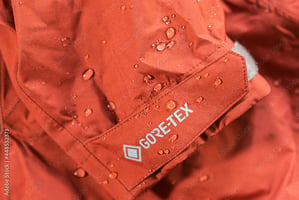Are you tired of getting soaked in the rain or feeling sweaty and uncomfortable during outdoor...
Does GORE-TEX Really Lose its Waterproofness?
Please imagine : you're out in the great outdoors, surrounded by breathtaking landscapes, and it starts to rain. But you're wearing your favorite GORE-TEX jacket, so you're confident you'll stay dry. Or will you? There's been a lingering debate about whether GORE-TEX truly lives up to its waterproof reputation. Well, hold on to your rain hats because we're about to reveal the truth.
In this article, we dive deep into the question: Does GORE-TEX really lose its waterproofness? We'll debunk myths, separate fact from fiction, and provide you with the information you need to make an informed decision before your next outdoor adventure.
GORE-TEX has long been hailed as the go-to technology for waterproof and breathable gear. But with various opinions floating around, it's time to get to the bottom of this. Can your GORE-TEX gear stand up to torrential downpours, or will it leave you feeling soggy and disappointed?
Join us as we uncover the real story behind GORE-TEX's waterproofness and explore the science behind this legendary outdoor material. Prepare to be surprised and enlightened as we lay bare the truth about GORE-TEX.
Understanding the waterproof technology of GORE-TEX
GORE-TEX has long been hailed as the go-to technology for waterproof and breathable gear. Developed in the 1970s, this revolutionary material changed the game for outdoor enthusiasts. But how does it work?
GORE-TEX is made up of three layers: an outer layer, a waterproof membrane, and an inner layer. The outer layer is designed to repel water and protect the membrane, while the inner layer provides comfort and moisture-wicking properties. The magic happens in the middle layer, where the waterproof membrane is located.
This membrane is made up of microscopic pores that are smaller than a water droplet but larger than a vapor molecule. This means that while water cannot penetrate the membrane from the outside, moisture vapor from perspiration can escape from the inside, ensuring breathability. So, in theory, GORE-TEX should keep you dry even in the wettest conditions.
But is this always the case? Let's explore further.
Common misconceptions about GORE-TEX waterproofness
One of the most common misconceptions about GORE-TEX is that it loses its waterproofness over time. Some believe that with repeated use or exposure to certain conditions, the membrane deteriorates, compromising its ability to proof water effectively. However, this is not entirely accurate.
GORE-TEX is designed to be durable and long-lasting. The membrane is abrasion resistant and can withstand years of use without losing its waterproofing properties and without holes or other physical damage. In fact, GORE-TEX products go through rigorous testing to ensure their durability.
The membrane is the key, and we perceive Gore-Tex as basically laminated as if it were a single fabric. But it is essentially three layers, and the part we see is no different from ordinary nylon fabric. It is the invisible inner material that is GORE-TEX, and that is where the waterproof performance lies. The nylon fabric in between has no waterproofing properties.
Nevertheless, after some use, Gore-Tex clothing exhibits wet-like characteristics. What is this? In fact, it is called water repellency. In the case of GORE-TEX, this water repellency is called DWR (durable water repellency). It is the ability of GORE-TEX to repel water, so that even if the water repellency has not decreased, the wearer may feel wet.
Let's take a closer look at what this means.
What does reduced DWR mean to feel wet?
What does it mean that a decrease in water repellency makes a garment feel wet even if its water resistance has not decreased?
The key to this is how people feel wet. In fact, people do not feel wet or not wet on their skin, but rather they judge wetness based on changes in temperature.
By weakening the water repellency of Gore-Tex® clothing, water does not pass through, but the temperature is felt the same way as when it is wet. This is the mechanism by which the wearer feels wet, even though the water resistance has not decreased.
As mentioned earlier, GORE-TEX does not degrade in waterproofness unless it is physically damaged. However, its water repellency (DWR) degrades with use. Next, let's consider the factors that affect water repellency.
Factors Affecting GORE-TEX's Water Repellency (DWR)
Although GORE-TEX is known for its durability, certain factors can affect the inherent ability of GORE-TEX. One of the most significant factors is improper care and maintenance. To maintain the water repellency of GORE-TEX products, regular cleaning and re-pairing is necessary.
With each use, dirt, oil, and other contaminants accumulate on the surface layer of the fabric, clogging the pores and reducing breathability. This also affects water repellency. In addition, exposure to harsh chemicals such as chlorine and certain detergents can also affect water repellency.
Another consideration is the deterioration of the seam tape applied to the seams. Holes are made in the seams, and even if Gore-Tex material is used, water can enter through small holes. To ensure the waterproofing of the seams, a waterproof tape called seam tape is attached along the seams. Since this seam tape is bonded, it may deteriorate and peel off over time.
To prolong the life of your GORE-TEX product, it is important to follow the manufacturer's care instructions. Clean and re-repair (shown here to restore DWR) and continue to do so on a regular basis. Doing so will help maintain water repellency and extend the life of your GORE-TEX product.
How to maintain the waterproofness of GORE-TEX products
Proper care and maintenance are crucial for preserving the waterproofness of GORE-TEX products. Here are some tips to help you keep your gear in top shape:
- Cleaning: Regularly clean your GORE-TEX gear using a mild detergent and warm water. Avoid using fabric softeners or bleach, as they can damage the membrane. Follow the manufacturer's instructions for specific cleaning guidelines.
- Reproofing: After cleaning, it's essential to reproof your GORE-TEX gear. Reproofing helps restore the durable water repellency (DWR) coating on the outer layer, ensuring that water beads off the fabric instead of soaking in. Use a DWR spray or wash-in product specifically designed for GORE-TEX.
- repair (DWR recovery): After cleaning, it is important to restore the water repellency of your Gore-Tex gear. Restore the durable water repellent (DWR) coating on the outer fabric so that water beads up instead of soaking in. Use a DWR spray or wash-in product specifically designed for Gore-Tex.
- Storage: When not in use, store in a cool, dry place out of direct sunlight. Avoid compressing the fabric for extended periods of time, as this may affect its performance. Also, deterioration of the adhesive surface may cause the seam tape to peel or the fabric and GORE-TEX membrane to delaminate. To prevent delamination, it is important not to store the garment soiled. Storing off-season, after professional laundering, will help prevent delamination.
Follow these maintenance tips to keep your Gore-Tex gear waterproof and water-repellent and ready for your next outdoor adventure.
Testing the waterproofness of GORE-TEX
Various organizations and independent testers have developed rigorous methods to test the waterproofing properties of GORE-TEX outdoor gear. One such test is the hydrostatic test. Hydrostatic testing may be used to confirm if a fabric has invisible holes in it or if the adhesion of seam tape has weakened, making it less waterproof.
GORE-TEX products are extensively tested to meet specific waterproofing standards. GORE-TEX products undergo extensive testing to meet specific waterproofness standards. These tests ensure that the gear performs as expected in real-world conditions. It is important to note, however, that even the most waterproof materials have their limitations. Under extreme conditions, such as submersion in water, water may eventually enter through the fabric.
Nevertheless, GORE-TEX gear provides excellent waterproofing for most outdoor activities. Whether hiking, skiing, or simply walking in the rain, GORE-TEX will keep you dry and comfortable.
However, these tests are nearly impossible to perform on your own. In this case, it is best to consult a maintenance specialist. However, some maintenance specialists are able to perform these tests, while others are not. You should check in advance whether they have waterproofing testing facilities.
Real-life experiences and testimonials from GORE-TEX users
While scientific testing provides valuable insights into the waterproofness of GORE-TEX, nothing beats real-life experiences. Countless outdoor enthusiasts swear by the performance of GORE-TEX gear, sharing their adventures and testimonials online.
From mountaineers conquering the world's highest peaks to everyday hikers traversing challenging terrains, GORE-TEX has proven to be a reliable companion. Users often praise the gear for its ability to repel water, keep them dry, and maintain breathability, even during intense physical activity.
These real-life experiences serve as a testament to the effectiveness of GORE-TEX and its ability to live up to its waterproof reputation.
Alternative waterproof technologies to consider
While GORE-TEX is undoubtedly a leader in waterproof technology, it's not the only option available. Several other brands and materials offer similar performance and protection. Some notable alternatives include:
- eVent: Hydrophobic porous uncoated ePTFE membrane. It is made of the same PTFE as Gore-Tex, but is not coated, making it easier to increase moisture permeability than Gore-Tex.
- NeoShell: Developed by Polartec, NeoShell is a hydrophobic porous PU membrane that combines breathability and waterproofness without sacrificing comfort. Stretchable and flexible, it is ideal for activities that require a wide range of motion.
- Pertex Shield: A material called a hydrophilic non-porous PU membrane. Non-porous PU membranes are basically hydrophilic, with no pores, and they breathe moisture through a mechanism in which hydroxyl groups in the membrane combine with water vapor to retain water inside the membrane, which then evaporates and releases it.
GORE-TEX has become a popular choice among outdoor enthusiasts due to its long-standing reputation and proven performance.
Debunking myths: Does GORE-TEX really lose its waterproofness?
Now that we have explored the science behind GORE-TEX, the factors that affect its waterproofing properties, and the experiences of actual users, it is time to get to the main question, "Does GORE-TEX really lose its waterproofing properties?"
The answer is both yes and no. While GORE-TEX itself is a material that does not lose its waterproofing properties, there is an imperfection when viewed as a fabric, and that is its water repellency (DWR). With proper care and maintenance, this water repellency can be restored after prolonged or repeated use. However, Gore-Tex garments that are not washed and maintained should be considered to have lost their original performance.
Conclusion: The truth about GORE-TEX waterproofness
In conclusion, GORE-TEX is a reliable and durable technology that lives up to its waterproof reputation. While it may not be immune to the effects of improper care or extreme conditions, the majority of outdoor enthusiasts can trust GORE-TEX to keep them dry and comfortable in various weather conditions.
Remember, proper care and maintenance are critical to maintaining the original performance of your GORE-TEX products. Regular cleaning, re-pairing, and inspection should be performed to ensure that your GORE-TEX products are performing at their best.
So, the next time you head out into the great outdoors, rest assured that your GORE-TEX gear will provide the protection you need to stay dry, allowing you to fully enjoy your outdoor adventures, rain or shine.



